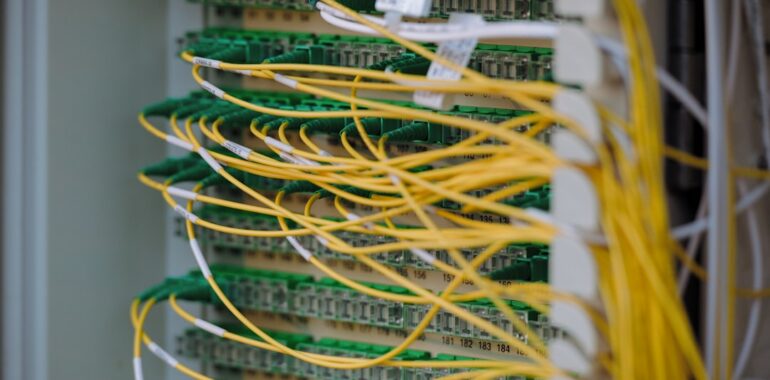Understanding AI Networking Developments: The Role of UEC and GPU Clusters

SEO Meta Description: Stay informed on AI networking developments, focusing on the UEC and the impact of GPU clusters in transforming AI infrastructure and performance.
Introduction
In the rapidly evolving landscape of artificial intelligence (AI), AI networking has emerged as a critical component driving performance and scalability. As organizations strive to harness the full potential of AI technologies, understanding the latest developments in AI networking is essential. This article delves into the pivotal roles played by the Ultra Ethernet Consortium (UEC) and GPU clusters in shaping the future of AI infrastructure and performance.
The Importance of AI Networking in AI Infrastructure
AI networking refers to the specialized network architectures and technologies designed to support the high demands of AI workloads. Unlike traditional networking, AI networking must handle massive data transfers, low latency, and high bandwidth requirements essential for tasks such as training complex machine learning models and real-time inference.
A robust AI networking infrastructure ensures that data flows seamlessly between GPUs, storage systems, and other critical components, thereby minimizing job completion time (JCT) and maximizing resource utilization. As AI applications become more sophisticated, the underlying network’s ability to support these demands becomes increasingly vital.
Understanding the UEC’s Role in AI Networking
The Ultra Ethernet Consortium (UEC) has been at the forefront of revolutionizing AI networking. Traditionally, InfiniBand has been the go-to technology for AI networking due to its superior performance in handling remote direct memory access (RDMA) traffic. However, InfiniBand comes with significant drawbacks, including high costs, vendor lock-in, and the need for specialized skill sets.
UEC aims to address these challenges by developing Ethernet fabrics that can rival or surpass InfiniBand’s performance. Their approach involves innovative load-balancing techniques and advanced congestion management to ensure high efficiency and reliability in AI networks. By focusing on creating a scalable and cost-effective Ethernet-based solution, UEC plays a crucial role in making AI networking more accessible and adaptable to various enterprise needs.
GPU Clusters: Transforming AI Performance
GPU clusters are the backbone of modern AI infrastructure, providing the computational power necessary for training and deploying AI models. However, the efficacy of GPU clusters heavily depends on the underlying network architecture. In large-scale deployments, where hundreds or thousands of GPUs work in tandem, the network must efficiently manage data traffic to prevent bottlenecks.
Enter GPU clusters optimized with advanced AI networking solutions. By integrating UEC’s Ethernet fabrics, GPU clusters can achieve near-InfiniBand performance without the associated costs and limitations. This integration results in reduced JCT, ensuring that expensive GPU resources are utilized effectively. Moreover, scalable GPU clusters facilitate the deployment of AI models across diverse industries, enhancing applications in finance, healthcare, insurance, and more.
Overcoming Challenges in AI Networking
One of the primary challenges in AI networking is managing elephant flows—large, long-lived data streams that can cause significant congestion and packet loss in the network. Traditional Ethernet networks struggle with these flows, leading to increased latency and reduced throughput.
UEC’s approach to AI networking tackles this issue head-on. By implementing a fabric-scheduled Ethernet mechanism that uses virtual output queues (VoQ) and grant-based flow control, UEC ensures non-blocking, congestion-free networking. This method distributes traffic evenly across the network fabric, preventing any single pathway from becoming overwhelmed. As a result, GPU clusters maintain optimal performance levels, and AI workloads proceed without interruption.
Another challenge is the reactive nature of some networking solutions, which address congestion only after it occurs. UEC’s proactive fabric approach mitigates this by redesigning the network fabric itself, eliminating the need for overly complex and expensive smart endpoints. This strategy not only enhances performance but also reduces costs and power consumption associated with AI networking hardware.
The Future of AI Networking
As AI continues to advance, the demand for sophisticated networking solutions will only grow. Innovations like UEC’s Ethernet fabrics and scalable GPU clusters are setting the stage for next-generation AI infrastructure. Future developments are expected to focus on further reducing latency, increasing data throughput, and enhancing the flexibility of AI networks to accommodate diverse and evolving AI applications.
Moreover, partnerships between AI solution providers, such as NetMind AI, and networking consortia like UEC will play a crucial role in driving these advancements. By leveraging comprehensive AI-powered tools and services, organizations can seamlessly integrate cutting-edge networking technologies, ensuring their AI initiatives remain competitive and efficient.
Conclusion
AI networking is a cornerstone of effective AI infrastructure, enabling the high-performance capabilities required for modern AI applications. The contributions of organizations like the Ultra Ethernet Consortium and the advancements in GPU cluster technologies are pivotal in transforming how AI systems operate. By overcoming traditional networking challenges and introducing innovative solutions, AI networking developments are paving the way for more efficient, scalable, and cost-effective AI deployments.
Embracing these advancements allows businesses to harness the full potential of AI, driving innovation and maintaining a competitive edge in an increasingly digital world.
Ready to Transform Your AI Infrastructure?
Discover how NetMind AI Solutions can elevate your enterprise with customizable AI integration. Visit us at NetMind AI to learn more and get started today!




